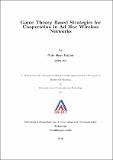Game theory based strategies for cooperation in ad hoc wireless networks
Abstract
In self-organized ad-hoc wireless networks, nodes belong to different authorities, pursue different goals, have constrains like energy; therefore, cooperation among them cannot be taken for granted. Non cooperation of nodes causes increase in probability of packet drop and increase in probability of route or network failure, which leads to poor network performance. On other hand if nodes always cooperate, network does not last for a long as nodes are energy constrained. Several schemes are proposed in literature based on incentive and reputation mechanism. All of them outperforms in their own set of assumptions and have certain issues.
<p/>Researchers started looking at game theory as a probable solution and proposed some schemes, but yet to come up with better solutions. We focus on optimization of service received by a node from network and delivered to network considering energy as constraint. We first derive the probability by which a node accept the relay request of other nodes based on energy constraint. Then apply game theory based schemes Generous Tit For Tat (GTFT), Neighboring GTFT (N-GTFT) and contrite Tit For Tat (C-TFT) for acceptance of relay requests; well known in economics, behavioral science and biology for cooperation. We find that all above mention scheme converges towards parato optimal values of service received and deliver to network in presence and absentia of noise in network. We find that when network has pair wise mixed strategies (any two from GTFT, N-GTFT and C-TFT) then also convergences remain same as it is for single strategy. But when there are 50% non cooperative nodes (Always Drops strategy), C-TFT is the dominating strategy. Also C-TFT copes up with 10% or more noise in the network as other strategy fail to do so, however they cope well with lesser amount of noise. At the end CTFT evolve as the dominating strategy when all strategies including Always Drops simulated under evolutionary method of comparison in noisy and noise free network. C-TFT out performs because it switches to mutual Tit For Tat after cooperating against fixed unilateral non cooperation from other nodes and also cope up with own unintentional defection caused by noise.
Collections
- M Tech Dissertations [923]
Related items
Showing items related by title, author, creator and subject.
-
Channel quality prediction and localization
Patel, Animesh (Dhirubhai Ambani Institute of Information and Communication Technology, 2007)In this thesis we focus on two problems, Channel Quality Prediction and Localization in wireless network. In High-Speed Downlink Packet Access (HSDPA) architecture of Universal Mobile Telecommunications Services (UMTS), ... -
Optical wireless sensor network design for a conducting chamber
Borkar, Abhishek (Dhirubhai Ambani Institute of Information and Communication Technology, 2011)Now a day’s majority of the wireless sensor networks (WSNs) are based on Radio Frequency (RF) communication technology. But RF when used in an environment like that of metallic, conducting chamber exhibits large amount of ... -
Energy efficient data gathering protocol for wireless sensor network
Rao, Parth A. (Dhirubhai Ambani Institute of Information and Communication Technology, 2008)Wireless Sensor Network is made up of hundreds and thousands of miniature electronic devices called node, which have sensors built on them. Functionality of a sensor is entirely application dependent. They can perform a ...

